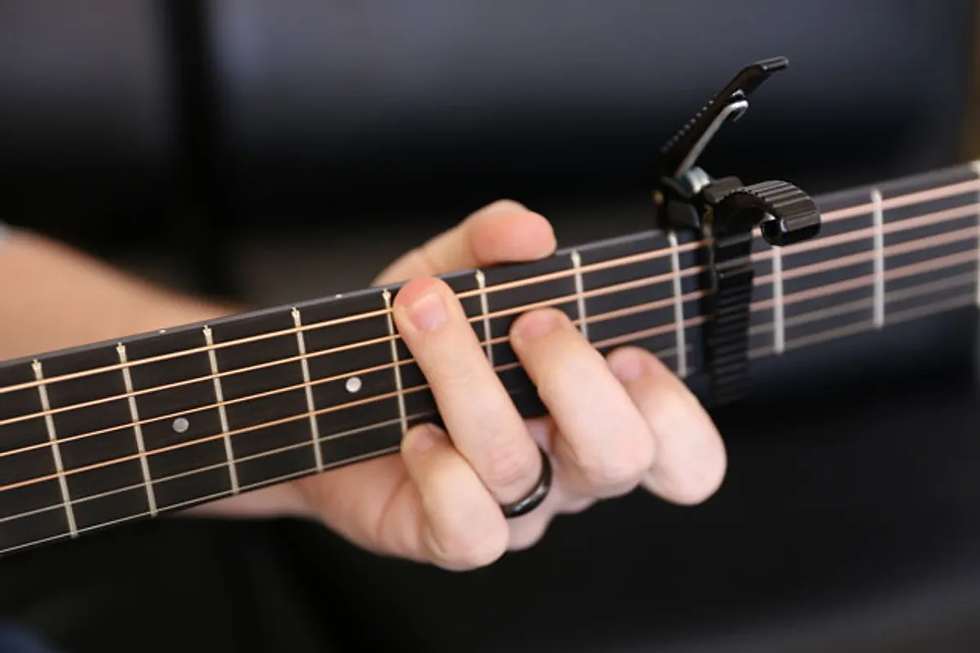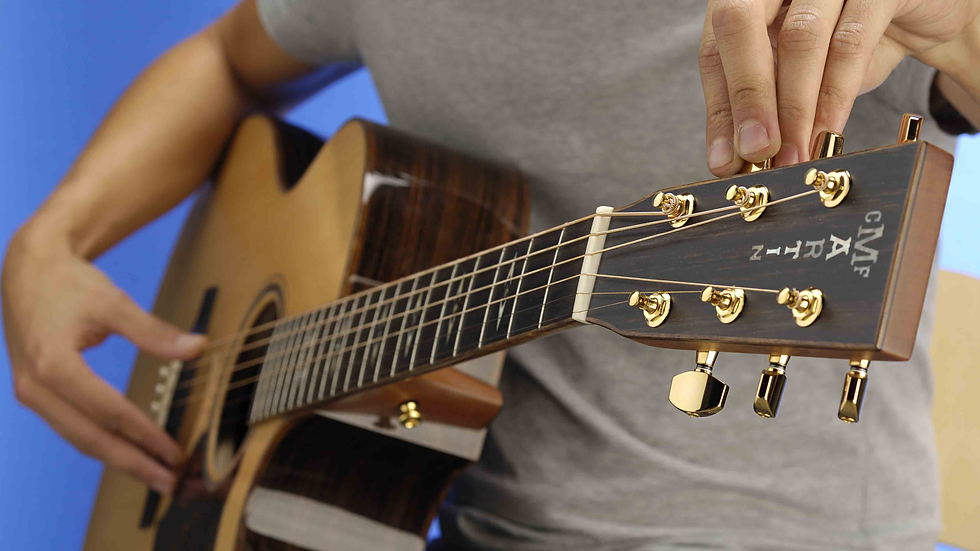Capo Magic!
- The American Guitar Academy

- Jul 12
- 7 min read
Updated: Jul 22
What is a Guitar Capo and How Do You Use It?
For beginner guitarists, learning to play different songs in various keys can feel like a bit of a puzzle. Luckily, there’s a handy little tool called a capo that can make things a whole lot easier! Whether you’ve seen a capo clamped onto the neck of a guitar or heard it mentioned in your guitar lessons, you may wonder what it’s for and how it works. Well, wonder no more! In this article, we’ll dive into the wonderful world of capos, showing you what they are, how to use them, and why they’re so helpful for guitar players—especially beginners.

What is a Capo?
A capo (short for capotasto, which is Italian for "head of the fretboard") is a small device that clamps onto the neck of your guitar, holding down all the strings at a specific fret. It’s like having an extra hand pressing on the fretboard! By shortening the length of the strings, the capo raises the pitch of the guitar, effectively moving everything up in pitch without requiring you to change your finger positions.
You can think of it as moving the "nut" (the part of the guitar near the headstock that the strings pass over) up the neck. When you use a capo, it’s like you’re starting from a new "zero point." This means that the chords you already know can be played higher up the neck, but they’ll sound like different chords—without you having to learn new fingerings.
There are a few different types of capos:
Clamp/Trigger Capos: These are the most common and easiest to use. You just squeeze them open and clamp them onto the fretboard.
C-Clamp Capos: These allow for more precise tension adjustment but take a little longer to move around.
Partial Capos: These only press down some of the strings, creating unique tunings and sounds.
Some of the most famous guitarists, like Ed Sheeran and James Taylor, use capos all the time to create beautiful, accessible music.
Why Use a Capo?
So, what makes a capo such a game-changer? Let’s break down some of the key reasons you’ll want to have a capo in your guitar toolkit:
Changing the Key
One of the most common reasons to use a capo is to change the key of a song without having to learn new chords. Imagine this: you’ve just learned a song in the key of G, but your friend (or your singing voice) sounds much better in the key of A. Instead of having to relearn the chords or figure out tricky barre chords, you can simply place the capo on the 2nd fret and voilà! You’re now playing in A, using the same easy chord shapes you already know.
Capos let you quickly adapt to a different key, which is especially helpful if you’re playing with others or singing along. It also saves you from learning complicated fingerings for new keys when you’re just starting out.
Maintaining Open Chord Voicings
Capos aren’t just about transposing keys—they also let you keep the bright, open sound of basic chord shapes (like G, C, D, and E). Open chords have a ringing quality that sounds great in folk, rock, and pop music. If you want that open sound but need to play in a different key, a capo lets you do just that. For example, if you’re playing in the key of C but want to keep using those familiar G chord shapes, place the capo on the 5th fret and keep playing your open G, C, and D chords—now you’re in C major!
Simplifying Chord Shapes
Barre chords can be tricky for beginners. The capo helps you avoid them in many situations. Instead of struggling with a B minor barre chord, you can place the capo on the 2nd fret and play an easy A minor shape. Boom—problem solved. The capo is your secret weapon for making hard songs easier.
Exploring Alternate Tunings
For the more adventurous guitarists, partial capos or using a capo in unusual places on the neck can create unique sounds and tunings without fully retuning the guitar. This opens up creative possibilities, allowing you to experiment with new sonic textures without the hassle of detuning.
How to Use a Capo: Step-by-Step
If you’ve got your hands on a capo and you’re ready to try it out, here’s how to get started. Don’t worry—it’s a simple tool to use, and you’ll be transposing songs like a pro in no time.
Step 1: Choose the Right Fret

The first thing you need to do is figure out where to place the capo. The fret you place it on will depend on the key you want to play in. For instance, if you want to move from the key of G to A, you’ll place the capo on the 2nd fret. Every fret you move the capo up raises the pitch by a half-step.
Capo on 1st fret: Raises pitch by one semitone.
Capo on 2nd fret: Raises pitch by two semitones (G becomes A, C becomes D, etc.).
Capo on 4th fret: Raises pitch by four semitones.
Step 2: Clamp the Capo

Next, you need to attach the capo to the fretboard. The trick is to place the capo just behind the fret, not directly on top of it. You want to make sure it’s tight enough that the strings are pressed down firmly (without buzzing), but not so tight that it sharpens the pitch of the notes. If you’re using a trigger-style capo, just squeeze it open, position it correctly, and let go.
Step 3: Play as Normal

Here’s the best part—once the capo is in place, you can play the exact same chord shapes you already know! The only difference is that they’ll sound higher in pitch. So, if you’re playing a G chord with a capo on the 2nd fret, it will actually sound like an A chord. But your fingers won’t know the difference!
Step 4: Retune if Necessary

Sometimes, using a capo can slightly pull the strings out of tune (especially if it’s clamped too tightly). It’s always a good idea to check your tuning after placing the capo to make sure everything sounds clean and in tune.
Capo and Transposition: How to Play Songs in Different Keys
One of the biggest benefits of using a capo is how easily it lets you transpose songs into different keys. Transposing is just a fancy way of saying "changing the key" of a song. Normally, transposing can involve some pretty complicated music theory or tricky chord shapes—but not with a capo!
Let’s say you want to play in the key of A, but you only know how to play the chords in G. No problem! Place the capo on the 2nd fret and play the G chord shapes you’re familiar with. Magically, you’re now in the key of A.
Here’s a quick cheat sheet to help you:
Capo on 1st fret: G chord becomes Ab.
Capo on 2nd fret: G becomes A.
Capo on 3rd fret: G becomes Bb.
Capo on 4th fret: G becomes B.
Capo on 5th fret: G becomes C.
Using the capo allows you to fit the song into the singer’s vocal range or adjust the key for other instruments without having to think too much about new chords.
Common Beginner Mistakes with a Capo and How to Avoid Them
Like anything new, learning to use a capo can come with a few hiccups. Here are some common mistakes and tips to avoid them:
Placing the Capo Incorrectly
If you put the capo too far from the fret, you’ll get buzzing or muted strings. Always place the capo just behind the fret (not directly on top of it) for the best sound.
Not Retuning
Capos can sometimes pull the strings slightly out of tune, especially if they’re clamped too tightly. Always check your tuning after placing the capo.
Over-Clamping
Speaking of clamping, if you squeeze the capo too tight, it can cause intonation issues, making notes sound sharp. Make sure your capo is snug, but not overly tight.
Relying Too Much on the Capo
While a capo is an excellent tool for simplifying songs, don’t let it become a crutch! As you get more comfortable, try learning barre chords and other advanced techniques so you’re not completely dependent on your capo.
Tips for Choosing the Right Capo
Not all capos are created equal, and finding the right one for your guitar can make all the difference. Here’s what to keep in mind:
Material and Durability: Choose a capo made from strong, durable materials. You don’t want something that’s going to break after a few uses.
Ease of Use: If you’re a beginner, a trigger-style capo is probably your best bet. It’s easy to use and fast to move between frets.
Size and Fit: Different capos work better for different types of guitars. Make sure the capo you’re using fits your guitar’s neck properly, especially if you’re playing a classical guitar with a wider neck.
Partial Capos: If you’re feeling adventurous, a partial capo can open up new creative possibilities by only pressing down some strings.
Popular Songs You Can Play with a Capo
Looking for some songs to try out with your new capo skills? Here are a few classic tunes that require a capo:
Ed Sheeran – “Perfect” (Capo on nd fret)
Oasis – “Wonderwall” (Capo on 2nd fret)
Taylor Swift – “All Too Well” (Capo on 5th fret)
Bob Dylan – “Don’t Think Twice, It’s Alright” (Capo on 4th fret)
These songs show how capos can simplify chord progressions while still allowing you to play along with the original recordings.
Play in all 12 Keys with a Capo!
A capo is one of the most useful tools a guitarist can have. It opens up new ways to play songs, helps you adapt to different keys, and lets you keep using your favorite chord shapes while exploring new sounds. Whether you're looking to make songs easier to play or just want to experiment with different keys, the capo is your best friend.
So, grab a capo, clamp it on your guitar, and see where it takes you! With a little practice, you’ll find yourself playing more songs, in more keys, and with more ease than ever before.



